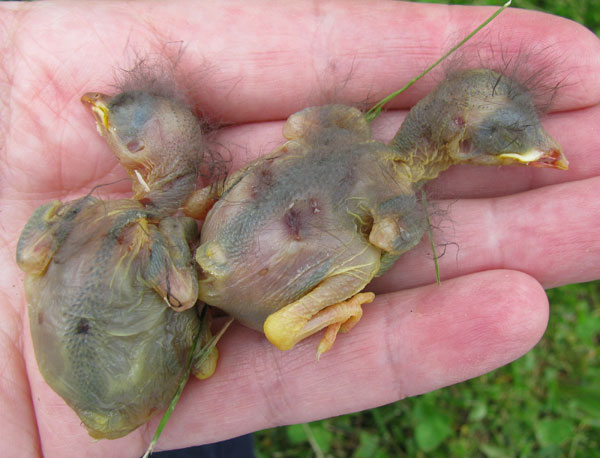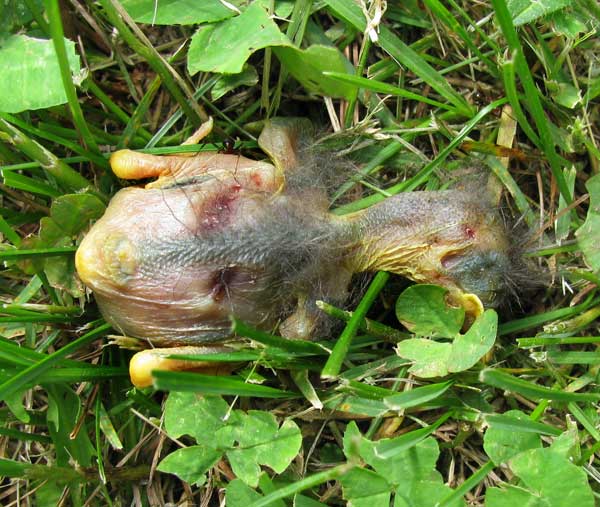

These Eastern Bluebird nestlings were killed by House Sparrows (HOSP.) They were found underneath the box. Notice the peck marks on the head, beak, and either side of the spine. The one on the left appeared to have a broken neck. See more photos and descriptions of HOSP attacks.
The box is located on an experimental trail where HOSP are not trapped. Instead, HOSP nests and eggs are removed on a weekly basis. The trail consists of six single-holed boxes, and four double-holed boxes (Two-holed mansions) on what I call the Hill Trail. See 2009 trail log and history below. It is a HOSP-infested location. This is the third year of the experiment. This nestbox where this attack occurred was protected both by monofilament stretched tightly on either side of the hole, and a sparrows spooker that was installed when the first bluebird eggs was laid.
On my other trails, I trap HOSP as soon as they attempt to use a box, and have never lost a nestling or an adult bluebird to a HOSP attack. Before this, I had never experienced a HOSP attack in a box protected by a sparrow spooker. I still highly recommend sparrow spookers in combination with other active and passive HOSP control methods, due to their strong track record.
History of this trail:
- In 2006, before I adopted the trail, 7 existing single-holed boxes were used by HOSP.
- In 2007, the single-holed boxes were plugged. I installed five two-holed mansions (donated by Linda Violett), to see if I could duplicate her success with Western Bluebirds nesting in HOSP-infested areas where no trapping occurs. The boxes were hung in trees. One was stolen. Two had failed Tufted Titmouse nestings (HOSP or House Wren attacks). One box had a single late bluebird nesting which successfully fledged two young. Flying squirrels occupied one box. Any HOSP nests/eggs were destroyed.
- In 2008, the single-holed boxes were unplugged, apparently by the person who installed them in the first place. Again, no trapping took place – HOSP nests and eggs were destroyed. A bluebird successfully produced three broods in the single-holed boxes. Each of her nests was protected by a sparrow spooker. A dead adult House Wren was found in one box, sitting on eggs, cause of death unknown. A chickadee nest was lost, probably after the mother was killed by a cat. Other single holed boxes has HOSP attempts. Of the four remaining two-holed boxes, one had a failed titmouse nesting (House Wren attack suspected.) Two were occupied by flying squirrels. One had a successful nuthatch nesting.
- In 2009, HOSP have been attempting to nest in four of the six single-holed boxes. A sparrow spooker was also placed on this nest as soon as eggs were laid, and the box also had monofilament on it. The box next to it on one side of it is vacant. The box on the other side has had HOSP attempts (removed) and House Wren (HOWR) sticks. No HOSP material has yet been added to the box where the bluebird nestlings were killed. (The nestlings were too large for a House Wren to remove.)
- Another two-holed hanging box was stolen, but Tom Comfort made me a new box which I tried as a pole mount. Of the four double-holed boxes, three are hung in trees, and one is on a pole. Of the tree-hung boxes, one is being used by a nuthatch, one is occupied by a flying squirrel, and one is vacant. The pole-mounted box is also vacant.
Conclusions to date: (note short term of experiment and small number of boxes)
- I have spent a lot of time and effort removing HOSP nests and eggs for the past three years. In the meantime, those boxes were unavailable for use by native birds.
- By allowing HOSP to attempt to use boxes nearby, I probably exposed the nesting bluebird to increased danger.
- It is possible (no way to know for sure) that repeated removal of HOSP nests and eggs resulted in increased HOSP aggression, prompting the attack on a box that was protected by both monofilament and a sparrow spooker. (Some monitors refer to this as a “rampage.” ) The results were deadly. Apparently it was just a matter of time until luck ran out. My experience is consistent with what Paula Ziebarth found on an experimental trail where no trapping occurred, but HOSP nests and eggs were removed. A number of Tree Swallows were killed when they attempted to use boxes that they “believed” were unoccupied.
- As a result, I do NOT plan to continue the no trapping part of the experiment in 2010. In my area, bluebird nests are too few and far between to take this kind of risk, and it is too dangerous for the bluebirds. However, I feel that the experiment was informative, and still believe alternatives are needed for people who are unable to or choose not to trap HOSP (probably about half of all people with nestboxes fall into this category).
- The two-holed hanging mansions do not seem to hold much appeal for bluebirds based on usage to date. Titmice and nuthatches seem attracted to them, therefore I would recommend their use for those species.
- Two holed boxes probably do increase the odds that a bluebird could escape from a HOSP attack if they were able to break free from the HOSP’s crushing beak and leg holds. Bluebird eggs and nestlings have no such option.
Related topics:
- More HOSP Photos
- HOSP in flight photo
- HOSP Control – Passive and Active Options
- History
- Attacks (warning: graphic photos)
- Photos and descriptions of other brown birds that look like HOSP
- HOSP Biology
- Population Proliferation
- Video Clip of HOSP Attack
- information on euthanizing captured birds
- HOSP advisory handout for people with boxes used by HOSP and one for commercial facilities allowing HOSP to breed/roost/feed
- HOSP trap review
- Essay “Are HOSP Evil?“
- separate webpages with drawings and photos on sparrow spookers, Magic Halo, and How to Trim Wings and Links for more information and DIY drawings.
- Deterring House Wrens
- All about nuthatches
- All about titmice
- Do No Harm
Previous Pictures of the Week: © Original photographs are copyrighted, and may not be used without the permission of the photographer. Please honor their copyright protection. If you would like to use a photo for educational purposes, you can contact me.
- Tips for photographing cavity nesters
- June 11, 2006 – Great Crested Flycatcher
- June 19, 2006 – Snake Lick
- June 26, 2006 – House Finch Nest
- July 3, 2006 – Tree Swallow in Flight
- July 17, 2006 – Bluebird Battle
- July 24, 2006 – Bear Attack
- August 1, 2006 – Neglected Nestboxes (House Sparrow nests)
- August 14, 2006 – Threesome (Bluebird Babes)
- August 28, 2006 – Peering (flicker)
- January 2007 – New Hill Trail (Sialis)
- February 12 2007 – Sharp-shinned? Hawk feeding on dead starling
- February 19, 2007 – Joe’s Cafe (Suet/Mealworm Feeder)
- March 25, 2007 – Sunflower Eater
- February 2007 – Snags & Suet (Pileated Woodpeckers)
- May 2007 – Birdcam Shots and Birdcam Photo Album
- May 12, 2007 – Carolina Wren nest in a boot
- May 25, 2007 – Batman Bird (Tree Swallows)
- June 2007 – Bluebird nest of cattails, one with leaves, and a TRES nest with maple seeds
- June 20, 2007 – Nine Egger (Tree Swallow nest)
- June 27, 2007 – Black-capped Chickadees (funny and serious photos)
- July 7, 2007 – Anting and Sunbathing
- Red-shouldered Hawk perching on nestbox
- November 18, 2007 – Western Bluebirds at the Spa
- March 15, 2008 – Under Construction – Eastern Bluebirds Building a Nest
- April 9, 2008 – Bluebird Battle in PA
- April 10, 2008 – Mouse Surprise
- April 15, 2008 – Bluebird News (nest in paper box)
- April 23, 2008 – My personal nightmare
- April 25, 2008 – Brave White-breasted Nuthatch
- April, 2008 – How an egg hatches
- May 3, 2008 – Newborn Blue (baby hatching)
- May 3, 2008 – Brave Blue (female on nest)
- May 14, 2008 – House Wren Havoc (eggs pecked)
- May 25, 2008 – House Wren Takeover (of nest, more pecked eggs)
- May 29, 2008 – Take Your Pick (parents feeding fledgling)
- June 10, 2008 – That Look Belongs in a Holster (female MOBL)
- August 23, 2008 – Cat on Nestbox
- September 28, 2008 – HOSP on the House
- October 10, 2008 – Cuddling nestlings (taken in summer time)
- October 27, 2008 – HOSP in flight
- October, 2008 – Possible double and dwarf egg in one nest
- December 16, 2008 – The Next Generation (children building boxes)
- January 22, 2009 – Blue with Cold
- January 28, 2009 – Prothonotary Warbler on a camper | Nest building PROW | PROW nesting in tree cavity
- May, 2009 – To Kill a Mockingbird (Snake eating mockingbird – may be disturbing)
- May 21, 2009 – Should I Stay or Should I Go Now? (Titmouse nestling in box)
- May 25, 2009 – Which of these is not like the others? (Cowbird egg)
- May 23, 2009 – The Honeypot at the end of the rainbow (bumblebee nest)
- June 20, 2009 – House Wren nest decorated with Western Bluebird feathers
- June 20, 2009 – Wonderful WEBLS of WA
- June 20, 2009 – Bluebirds of Bickleton
- July 12, 2009 – Hairy Shrimp (newborn bluebirds)
- July 2009 – Diet (bluebird with earthworm in beak)
- July 2009 – Bluebirds nesting outside of cavity
- July 19, 2009 – HOSP on Holiday
- July 20, 2009 – Pink bluebird eggs
- August 2, 2009 – Pinkies (baby mice)
- August 2, 2009 – En garde (male bluebird in box)
- September 29, 2009 – 1917 instructions for bird house construction
- I forget when – Rainbox
- April 11, 2010 – nuthatch bark
- April 12, 2010 – My first white egg
- April 12, 2009 – TUTI nest by Keith Kridler
- May 2010 – TUTI newborns
- May 2010 – Christmas Chickadee
- May 2010 – Bluebird and Chickadee eggs in the same nest
- June 2012 – Paparazzi
- April 2013 – Under Construction – Titmouse nestbuilding
- July 2013 – Pink Bluebird Eggs
- July 2014 – Cowbird egg in Eastern Bluebird nest
- July 2014 – Newborn HOSP
- July 2015: Patience Pays (Male Eastern Bluebird)
You cannot begin to preserve any species of animal unless you preserve the habitat in which it dwells. Disturb or destroy that habitat and you will exterminate the species as surely as if you had shot it. So conservation means that you have to preserve forest and grassland, river and lake, even the sea itself. This is vital not only for the preservation of animal life generally, but for the future existence of man himself—a point that seems to escape many people.
-Gerald Durrell, The Nature Conservancy
